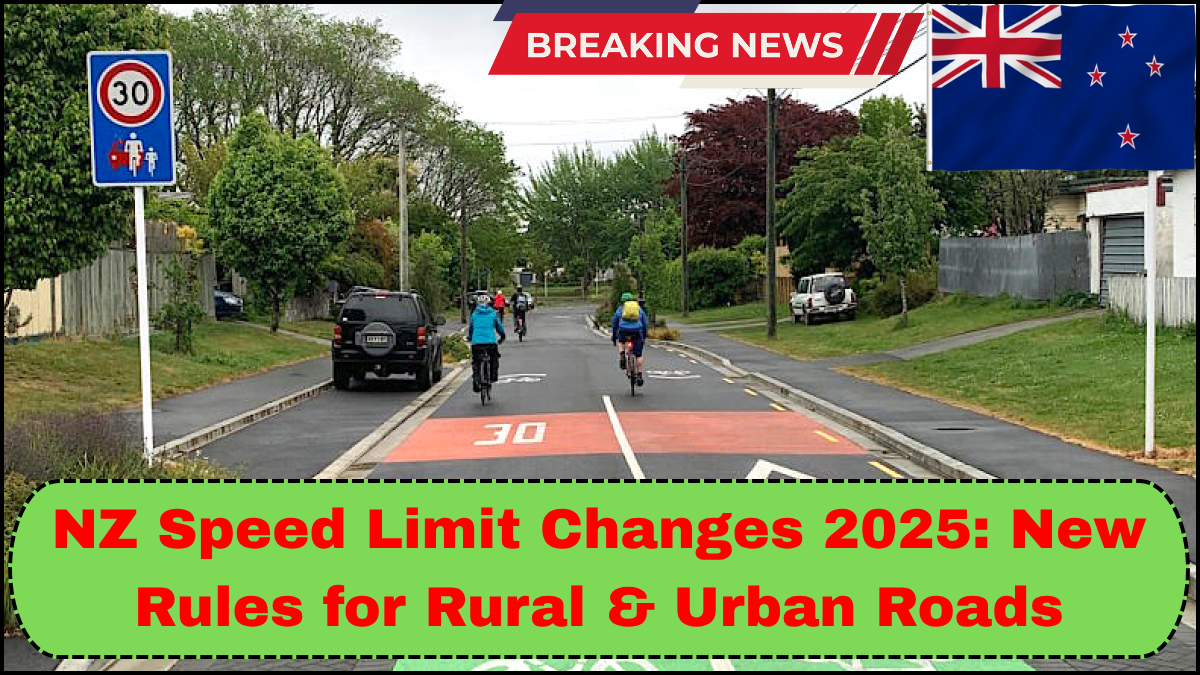New Zealand is on the cusp of a significant shift in its road safety strategy. The NZ Speed Limit Changes 2025 represent a nationwide effort to reduce road fatalities and create a safer driving environment, particularly in high-risk areas. With rural roads posing unique dangers and urban areas becoming increasingly congested, the government is rolling out targeted speed reductions that reflect a more evidence-based and location-specific approach.

Why Are the NZ Speed Limit Changes Happening?
The motivation behind the NZ Speed Limit Changes 2025 is clear: too many lives are lost or permanently altered due to high-speed crashes. According to Waka Kotahi NZ Transport Agency, speeding is a factor in around a third of fatal crashes in the country. As part of the Road to Zero strategy, the government aims to cut road deaths by 40% by 2030. Revising speed limits is a critical part of that plan.
These changes aren’t just blanket reductions. They’re carefully assessed modifications aimed at balancing road efficiency with safety, based on data analysis, traffic patterns, and feedback from local communities.
Speed Limit Changes in Rural Areas
What’s Changing?
Rural roads are often narrow, winding, and not designed for high-speed travel. Many existing limits—often 100 km/h—are out of sync with the road quality and usage. Under the NZ Speed Limit Changes 2025, many rural speed limits will be dropped to 80 km/h or even 60 km/h in certain areas known for crash history or poor visibility.
Examples of Impacted Areas
-
Remote highways and local country roads in regions like Waikato and Northland are being reassessed.
-
High-risk corridors, such as the stretch between Taupō and Napier, are undergoing safety audits with lower speed limits planned.
-
Rural schools and marae zones are being prioritized for 60 km/h or lower speed limits during peak times.
Why It Matters
Slowing down on rural roads drastically reduces the severity of accidents. A crash at 80 km/h is significantly less likely to be fatal than one at 100 km/h. Lower limits give drivers more time to react, especially on roads that may have sharp corners, hidden driveways, or agricultural traffic.
Speed Limit Reductions in Urban Areas
Safer Speeds Where It Counts
Urban areas, particularly in city centers, school zones, and residential neighborhoods, are also being targeted. Under the 2025 changes:
-
30 km/h will become standard in central business districts (CBDs) of cities like Auckland, Wellington, and Christchurch.
-
40-50 km/h will be the new norm for suburban streets, especially those with high pedestrian activity or near schools and hospitals.
Case Study: Auckland’s Vision Zero
Auckland Transport has already implemented reduced speed zones across dozens of neighborhoods with notable success. Early data shows a 30-40% drop in serious injuries within those zones. The NZ Speed Limit Changes 2025 aim to replicate this model nationally.
Urban Safety Focus
Reducing speeds in urban areas not only protects pedestrians and cyclists but also creates more livable communities. Studies show that people are more likely to walk or bike when vehicle speeds are lower, leading to improved public health and reduced congestion.
Enforcement and Compliance
How Will These Changes Be Enforced?
-
Increased signage and road markings will support awareness of new limits.
-
Mobile speed cameras and automated enforcement technology will be expanded.
-
Public education campaigns will roll out alongside the new rules to ensure drivers understand why the changes are happening and what the penalties are for non-compliance.
Transition Period
The speed limit changes will roll out gradually, starting in the highest-risk areas. Local councils will have input on timing and implementation, and drivers will be given advance notice before enforcement begins.
FAQs: NZ Speed Limit Changes 2025
Q1: When will the new speed limits take effect?
A: The rollout begins in early 2025, starting with high-risk rural and urban zones. The full transition is expected to continue through 2026.
Q2: Will all rural roads be reduced to 80 km/h?
A: Not all. Reductions will be based on specific risk assessments, but many secondary and local rural roads are expected to adopt lower limits.
Q3: What about motorways and expressways?
A: Most major highways with controlled access will retain their current speed limits, though some entry/exit zones may see changes.
Q4: How will I know if I’m in a reduced-speed area?
A: Clear signage and road surface markings will identify all updated zones. In urban areas, many zones will include gateway signs and speed bumps.
Q5: Are speed limit changes permanent?
A: Yes, unless future road safety data indicates a reason to adjust again. All changes are reviewed periodically based on crash statistics and traffic patterns.
click here to learn more